check oil AUDI A8 2013 User Guide
[x] Cancel search | Manufacturer: AUDI, Model Year: 2013, Model line: A8, Model: AUDI A8 2013Pages: 318, PDF Size: 79.34 MB
Page 238 of 318
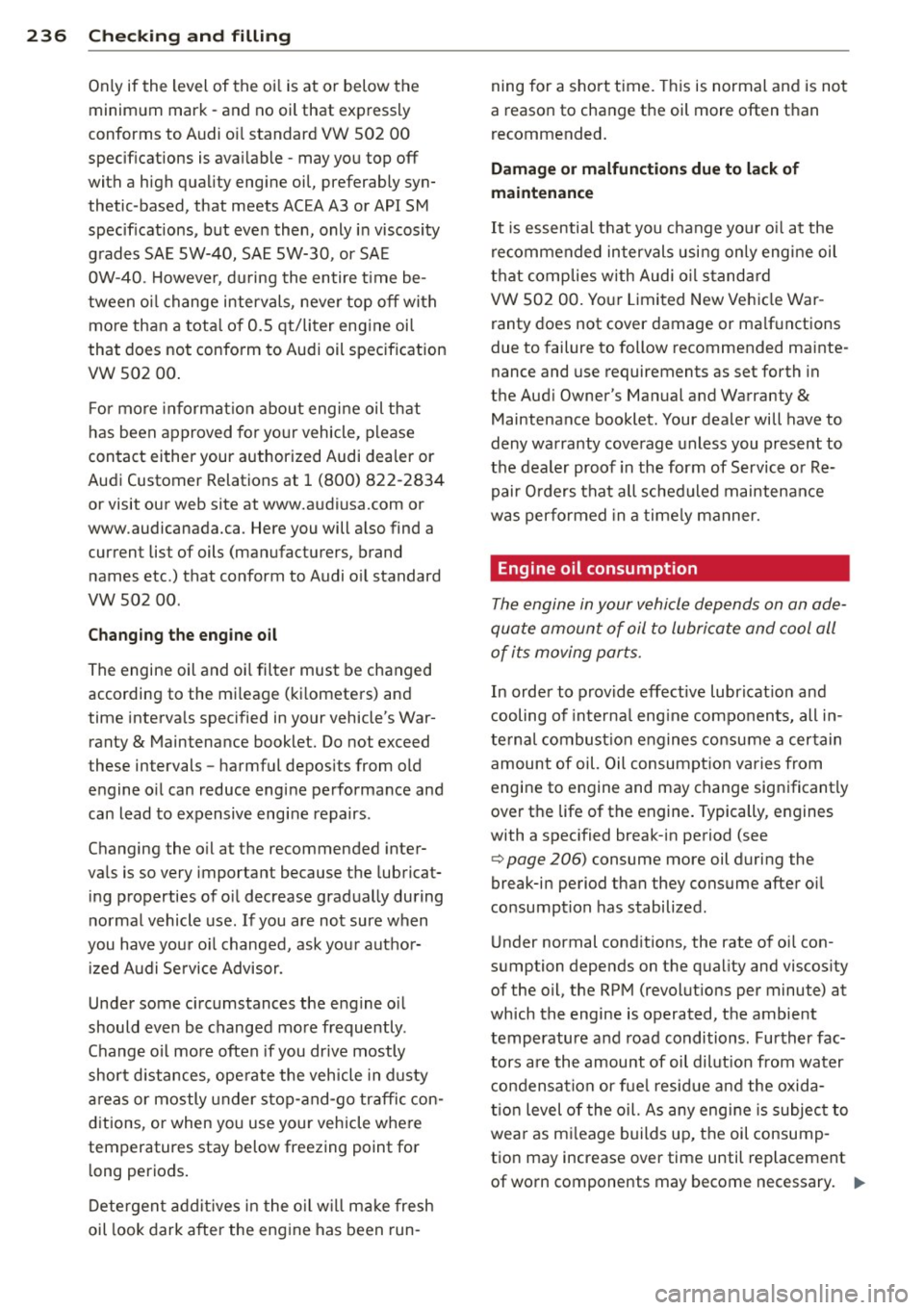
236 Check ing and filling
Only if the level of the oi l is at or below the
minimum mark -and no oil that expressly
conforms to Audi o il standard VW 502 00
specifications is ava ilable - may you top off
with a high quality eng ine oil, preferably syn
thetic -based, that meets AC EA A3 or API SM
specif ications, but even then, only in viscos ity
grad es SAE SW-40, SA E SW-30 , or SAE
OW-40. Howeve r, during the en tire t ime be
tween oi l change intervals, never top off with
more than a tota l of 0.5 qt/liter eng ine oi l
that does not conform to Audi oil specification
vw 502 00 .
F or more informa tion about engine oil that
has been approved for yo ur vehicle , please
contact either your authorized Audi dealer or
Audi Customer Relations at 1 (800) 822-2834
or visit our web site at www.audiusa.com or
www.audicanada.ca . Here you will a lso find a
current list o f oils (manufacturers, brand
names etc .) that conform to Audi o il standard
vw 502 00.
Chang ing the engine oil
The engine oil and oi l filter must be changed
according to the m ileage (ki lometers) and
time interva ls specified in your vehicle's War
ranty
& Maintenance booklet. Do not exceed
these in tervals -harmful depos it s from old
engine o il can reduce engine performance and
can lead to expensive eng ine repairs .
Changing the o il at the recommended inter
va ls is so very important because the lubricat
ing p roperties of o il decrease gradually during
norma l vehicle use. If you are not sure when
you have you r o il changed, ask you r autho r
iz ed Audi Service Advisor.
Under some c ircumstances the engine o il
should even be changed more frequently .
Change oi l mo re often if you drive mostly
short d istances , ope rate the vehicle in dusty
a reas or mostly under s top-and-go tr affic con
d itions , or when yo u use your vehicle whe re
temperatures stay below freezing point for l ong periods .
D etergen t add itives in the o il w ill mak e fresh
oil look dark after the eng ine has been run- ning for a sho
rt time. This is normal and is not
a reason to change the oil more often than
recommended.
Damage or malfunctions due to l ack of
maintenance
It is essentia l th at you c hange yo ur oil at the
r ecommended intervals usi ng on ly eng ine oil
that comp lies with Audi oi l standa rd
VW 502 00. You r Limited New Vehicle War
r anty does not cover damage or ma lf u nctions
due to failure to follow recommended ma inte
nance and use requirements as set forth in
the Aud i Owner's Manual and Warranty
&
Maintenance booklet. Your dealer will have to
deny warranty coverage unless you present to
the dealer proof in the form of Service o r Re
pair Orders that all scheduled maintenan ce
w as performed in a time ly m anner.
Engine oil consumption
The engine in your vehicle depends on an ade
quate amount of oil to lubri cate and
cool all
of its moving por ts .
In order to p rovide effective lubricat ion and
c ooling of inte rna l eng ine compo nents, all i n
tern al combust ion engines co nsume a cer tain
amount of oil. Oil consumpt ion varies from
engine to engine and may change significantly
over the life of the engine . Typically , engines
with a spec ified break-in period (see
¢ page 206) consume more oil duri ng the
break-i n period than they consume after o il
consumption has stabilized .
Under normal cond itions , the rate of oi l con
s u mption depends on the q uality and viscos ity
of the oil, the RPM (revolut ions per minu te) at
which the engine is operated, the ambient
temperature and road conditions. Further fac
tors a re the amount of oil dilut ion from water
c o ndensa tion or fue l resid ue a nd the oxida -
t ion level of the oil. As any engine is subjec t to
wea r as m ileage b uilds up, the oil consump-
tion may increase over time until replacement of wo rn components may become necessary. ..,..
Page 239 of 318
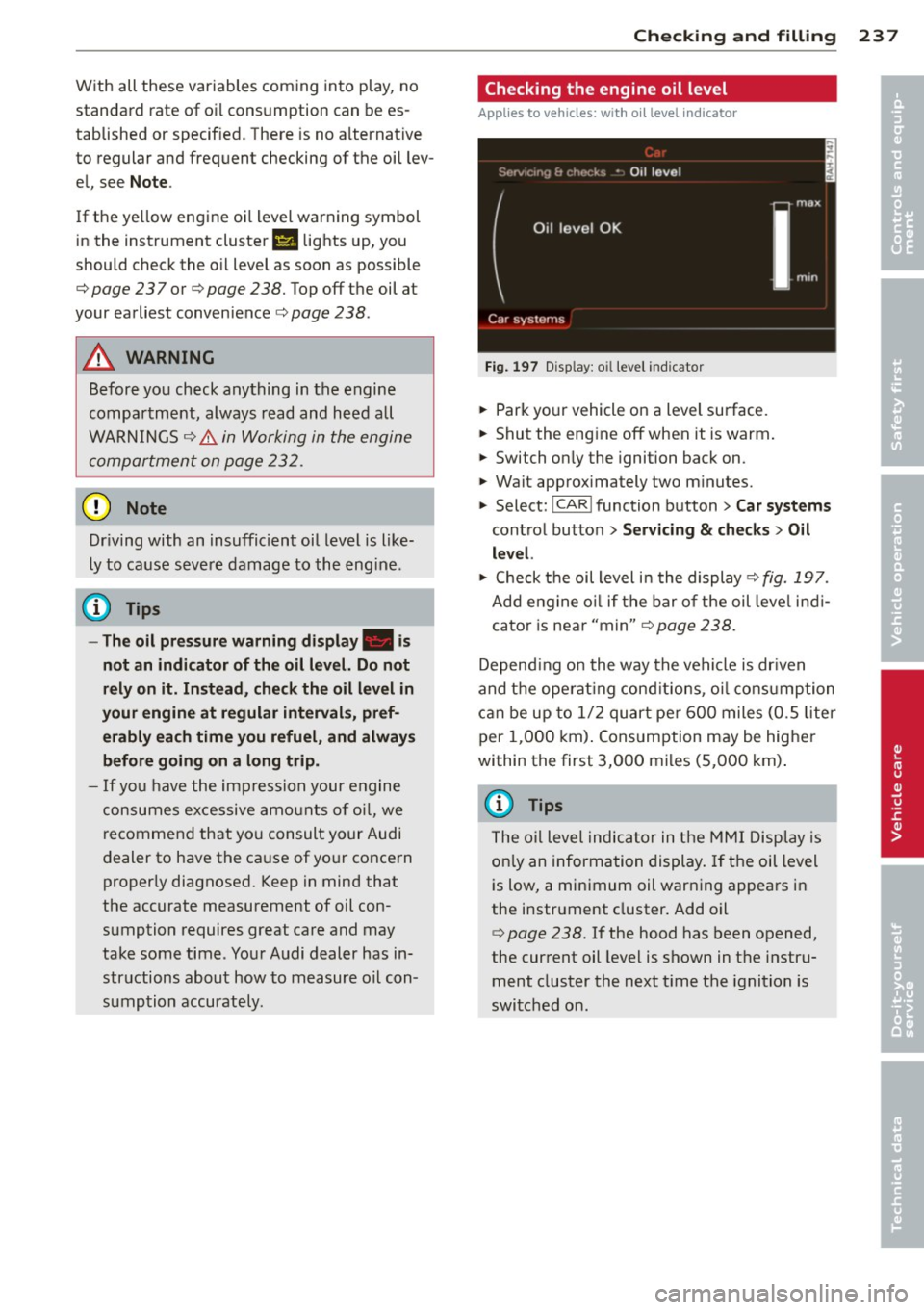
With all these variables coming into play, no
standard rate of oil consumption can be es
tablished or specified . There is no alternative
to regular and freq uent checking of the oi l lev
e l, see
Note .
If the ye llow engine oi l level war ning symbol
in the instrument cluster
II lights up, you
should check the o il level as soon as possible
¢
page 23 7 or ¢ page 238. Top off the oil at
your earliest convenience¢
page 238 .
.&_ WARNING
Before yo u check anything in the engine
compartment, always read and heed all
WARN INGS
¢ &. in Working in the engine
compartment on page 232.
0 Note
Dr iving with an insufficient oil level is like
ly to ca use seve re damage to the eng ine.
{1) Tips
- The oil pressu re warning display. i s
not an indicator of the oi l level. Do not
rely on it. Instead , check th e oil level in
your engine at regular interval s, pref
erably each time you refuel, and always before going on a long trip .
-If yo u have the impres sion your engine
consumes excessive amo unts o f oil, we
r ecommend that yo u consult your Audi
dealer to have the ca use of yo ur conce rn
proper ly diagnosed . Keep in mind that
the accurate measurement of oil con
sumption requires great care and may
take some time. You r Audi dealer has in
str uctions about how to measure o il con
sumption accurately.
Checkin g and fillin g 237
Checking the engine oil level
Applies to vehicles : wit h oil level indicator
Fi g. 1 97 Disp lay: o il leve l indicator
.,. Park yo ur vehicle on a level surface.
.,. Shut the eng ine off when it is warm .
.,. Switch on ly the ignition back on .
.,. Wait approx imately two m inutes.
.,. Select:
I CAR ! function button > Car systems
contro l butto n > Servicing & checks > Oil
level.
.,. Check t he oil level i n the display ¢ fig. 197.
Add eng ine o il if t he bar o f the oil leve l ind i
cator is near "min"¢
page 238.
Depend ing on the way the vehicle is dr iven
and t he ope rat ing cond it ions, oi l cons umption
c a n be up to 1/ 2 quart pe r 60 0 miles (0.S liter
per 1,000 km) . Cons umption may be higher
within the first 3,000 m iles (S,000 km) .
(D Tips
The o il leve l indic ato r in the MMI Disp lay is
on ly an informa tion display.
If t h e oil level
i s low, a minimum oil warn ing appears in
the instrument cluster. Add oil
¢
page 238. If the hood has been opened,
the current oil level is shown in t he instr u
ment cluster the next t ime the ignition is
swi tched on.
•
•
Page 240 of 318
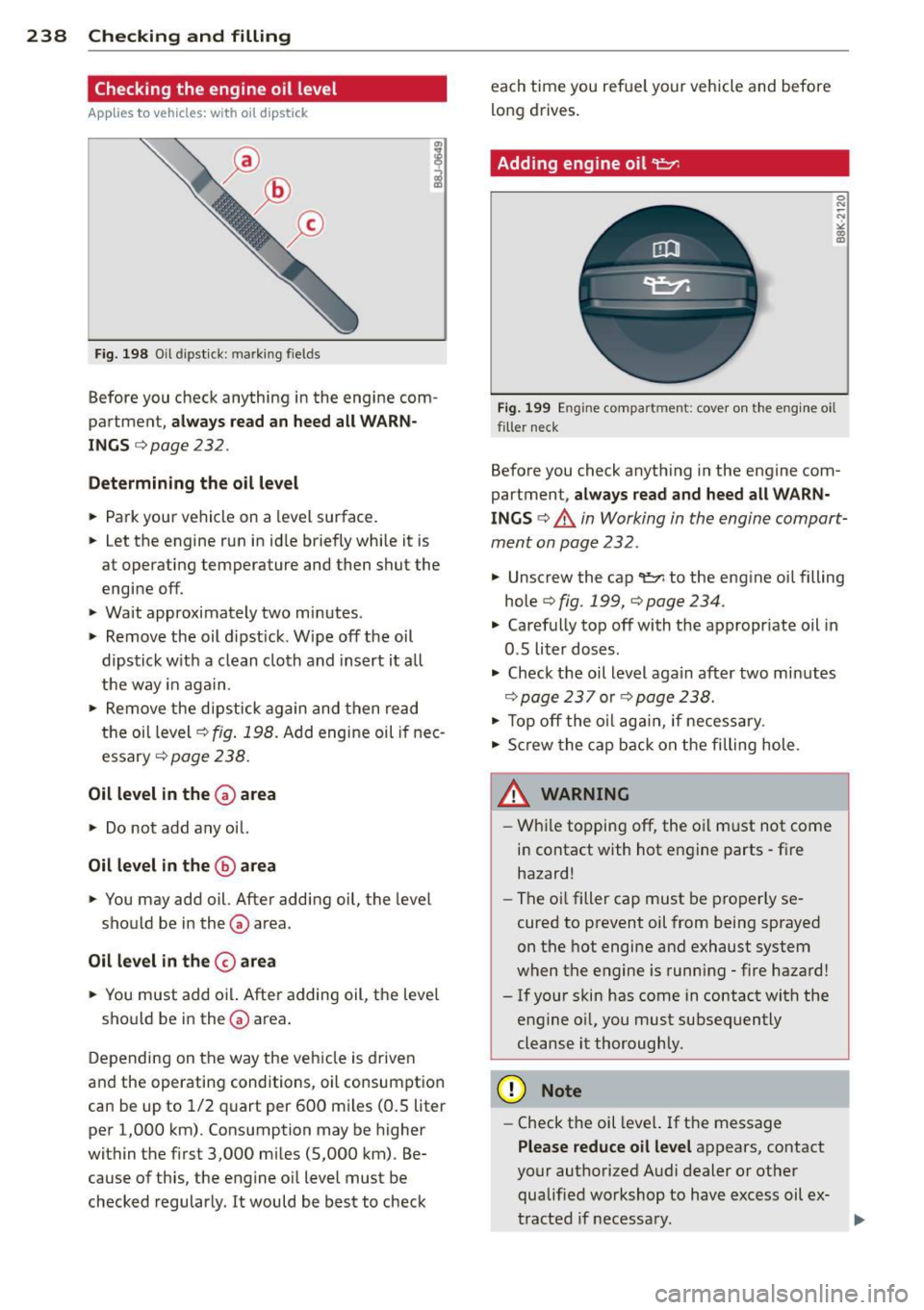
238 Checking and filling
Checking the engine oil level
App lies to vehicles: with oi l dipst ick
Fig. 198 Oil dipsti ck: marking fields
Before you check anything in the engine com
partment,
always read an heed all WARN
INGS c::;,page 232.
Determining the oil le vel
.. Park your vehicle on a leve l surface .
.. Let the engine run in id le b riefly while it is
at operating temperature and then shut the
engi ne off.
.. Wait approximately two min utes .
.. Remove the oil d ipst ick . W ipe off the oil
dip stic k w it h a clean cloth a nd insert i t all
t h e way in aga in .
.. Remove the dipstick again and t hen read
t h e oi l level
¢ fig . 198. Add engine oil if nec
essary
¢ page 238.
Oil level in the~ area
.. Do not a dd any oi l.
Oil level in the @area
.. You may add oil. After adding oil, the level
shou ld be i n the
G) area.
Oil level in the 0 area
.. You must add o il. Afte r adding oil, t he leve l
sho uld be in the
G) area .
D epending on the way the vehicle is drive n
a nd the operating conditions, oil consumpt ion
can be up to 1/2 q uart per 600 mi les (0.5 liter
per 1 ,000 km) . Cons umption may be higher
wit hin the f irst 3,000 mi les (5,000 km) . Be
cause of th is, t he engine o il level must be
checked regularly . It would be best to check each time you ref
ue l your vehicle and before
lo ng d rives .
Adding engine oil~
0 N ,.
"' 0:, m
Fig. 199 En g in e co mpa rtm ent : cove r on th e eng in e o il
f il le r neck
Befo re you check anyth ing in the engine com
partment,
always read and heed all WARN
INGS c::;, A in Working in the engine compart
ment on page 232 .
.. Unscrew the cap "l!:ir. to the eng ine oi l filling
hole
c::;, fig . 199, c::;, page 234 .
.. Carefully top off with t he appropr iate oil in
0 .5 li ter doses.
.. Check the oil level again after two minut es
c::;, page 237 or ¢ page 238 .
.. Top off the o il agai n, if neces sary.
.. Scr ew the ca p ba ck on the fi lling hole.
A WARNING
- W hil e to ppin g off, the o il m ust not co me
i n contact with hot en gine parts -fir e
hazard!
- Th e o il filler cap must be pr ope rl y se
cured to p revent oil from being sprayed
on the hot engi ne and e xhaust system
when t he engine is runn ing -fire haza rd !
- If you r skin has come in contact wit h the
e ng ine o il, you must subseq uently
cleanse it thor oughly.
(D Note
- Check the oil leve l. If the message
Please reduce oil level appears, contact
yo ur authorized A ud i d ealer or othe r
qualified worksh op to have excess oil ex-
t ract ed if necessa ry. .,,_
Page 241 of 318
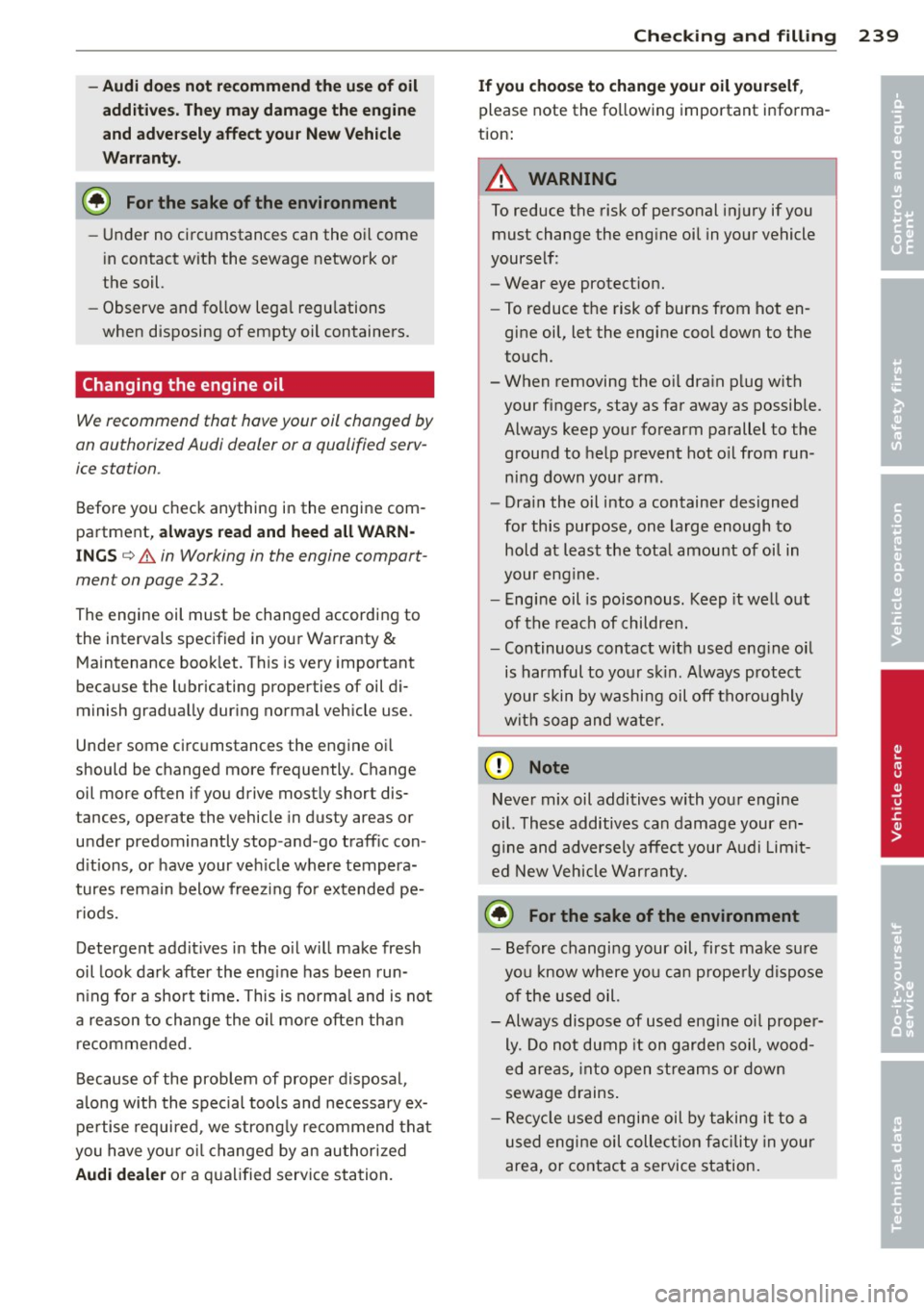
-Audi doe s not recommend the use of oil
add iti ve s. T he y ma y damage the engine
and ad ve rse ly affect you r New Vehicle
Wa rrant y.
@ For the sake of the environment
- Under no circumstances can the oil come
in contact with the sewage network or
the soil.
- Observe and follow lega l regu lations
when disposing of empty oil containers.
Changing the engine oil
We recommend that hove your oil changed by
on authorized Audi dealer or a qualified serv
ice station .
Before you check anything in the engine com
partment,
a lw ays r ead and heed all WARN
ING S
c:> &. in Working in the engine comport
ment on page 232.
The engine oil must be changed according to
the intervals specified in your Warranty
&
Maintenance booklet. This is very important
because the lubricating properties of oil di
minish gradually dur ing normal veh icle use.
Under some circumstances the engine oil
should be changed more frequently. Change
oil more often if you drive mostly short dis
tances, operate the vehicle in dusty areas or
under predominantly stop-and -go traff ic con
d itions, or have your veh icle where tempera
tures remain below freezing fo r extended pe
r iods.
Detergent additives in the o il w ill make fresh
oil look dark after the eng ine has been run
n ing fo r a short time. This is norma l and is not
a reason to change the oi l mo re often than
recommended.
Because of the problem of proper disposal,
along w ith the special tools and necessary ex
pe rtise required, we strong ly recommend that
you have your oi l changed by an author ized
A udi dealer or a qualified service station.
Checkin g and fillin g 239
If yo u choose to change you r oil yo urs elf ,
please note the fo llowing important informa
tion:
_& WARNING
To reduce the risk of personal injury if you
must change the engine oil in your vehicle
yourself:
- Wear eye protect ion.
- To reduce the risk of burns from hot en-
gine oil, let the engine cool down to the
touch.
- When removing the oi l dra in p lug with
your fingers, stay as far away as possible.
Always keep your forearm parallel to the
grou nd to help prevent hot o il from run
ning down you r arm.
- Dra in the oil into a container designed
for this purpose, one large enough to hold at least the tota l amount of oil in
your engine.
- Engine oil is poisonous. Keep it well o ut
of the reach of children.
- Continuous contact with used eng ine o il
is harmful to yo ur skin . A lways protect
your skin by washing oil off tho roughly
w it h soap and w ater.
d) Note
N eve r mix oil additives with your engine
oil. These additives can damage your en
g ine and adversely affect your Audi Lim it
ed New Vehicle Warranty.
@ For the sake of the environment
- Before changi ng your oil, first make sure
you know where you ca n prope rly dispose
of the used oil.
- Always dispose of used eng ine oi l proper
ly. Do not dump it on garde n soil, wood
ed areas, into open streams or down
sewage drains .
- Recycle u sed engi ne oil by taking it to a
used eng ine oil colle ct ion facility in your
area, or contact a service station.
•
•
Page 242 of 318
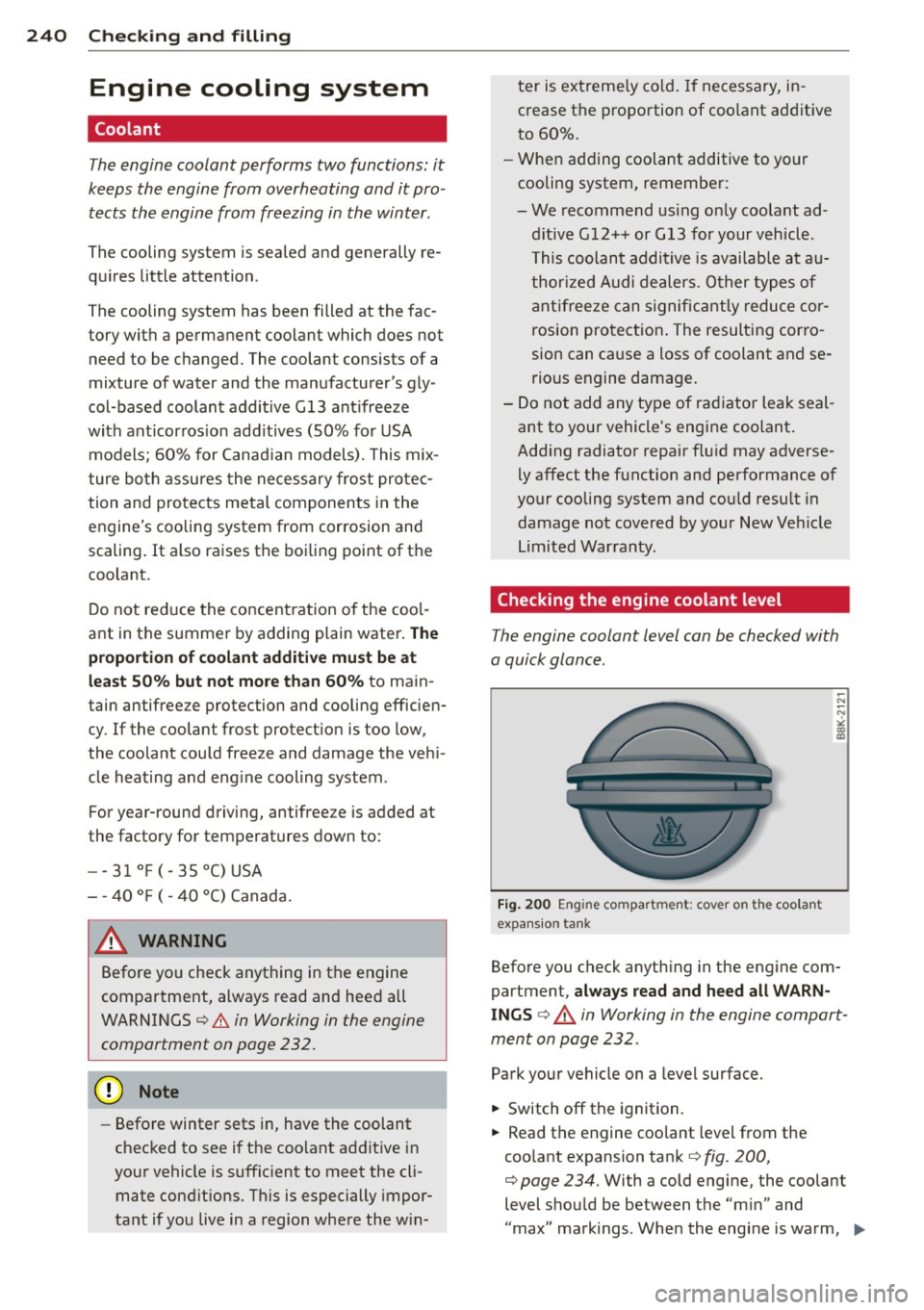
240 Checking and filling
Engine cooling system
Coolant
The engine coolant performs two functions: it
keeps the engine from overheating and it pro
tects the engine from freezing in the winter .
The cooling system is sealed and generally re
quires little attention.
The cooling system has been filled at the fac
tory with a permanent coolant which does not need to be changed. The coolant consists of a
mixture of water and the manufacturer's gly
col-based coolant additive Gl3 ant ifreeze
with anticorros ion add itives (50% for USA
models; 60% for Canadian models). This mix
ture both assures the necessary frost protec
tion and protects metal components in the
engine's cooling system from corrosion and
scaling. It also raises the boiling point of the
coolant.
Do not reduce the concentration of the coo l
ant in the summer by adding plain water .
The
proportion of coolant additive must be at
least 50% but not more than 60%
to main
tain antifree ze protection and cooling efficien
cy. If the coolant frost protection is too low,
the coolant could freeze and damage the veh i
cle heating and engine cooling system .
For year-round driving, antifree ze is added at
the factory for temperatures down to:
- -31°F(-35°C)USA
- - 40 °F ( - 40 °C) Canada.
A WARNING
Before you check anything in the engine
compartment, always read and heed all
WARNINGS
c:> &. in Working in the engine
compartment on page 232.
- Before winter sets in, have the coolant
checked to see if the coolant additive in
your vehicle is sufficient to meet the cli
mate conditions. This is especially impor
tant if you live in a region where the w in- ter
is extreme ly cold . If necessary, in
crease the proportion of coolant additive
to 60%.
- When adding coolant additive to your
cooling system, remember:
- We recommend using only coolant ad
ditive Gl2++ or Gl3 for your vehicle .
This coolant additive is available at au
thorized Audi dealers. Other types of
antifreeze can significantly reduce cor
rosion protection. The resulting corro
sion can ca use a loss of coolant and se
rious engine damage.
- Do not add any type of radiator leak seal
ant to your vehicle's engine coolant .
Add ing radiator repair fluid may adverse
ly affect the function and performance of
your cooling system and could result in
damage not covered by your New Vehicle
Limited Warranty.
Checking the engine coolant level
The engine coolant level can be checked with
a quick glance .
Fig. 200 Engin e compar tmen t: cover on t he coolant
expansio n ta nk
Before you check anything in the engine com
partment,
always read and heed all WARN
INGS c:> &. in Working in the engine compart
ment on page 232 .
Park your vehicle on a level surface .
.,. Switch off the ignition.
.,. Read the engine coolant level from the
coo lant expansion tank
c:> fig. 200,
c:> page 234. With a cold engine, the coolant
level should be between the "min" and
"max" markings. When the engine is warm, ..,
Page 243 of 318
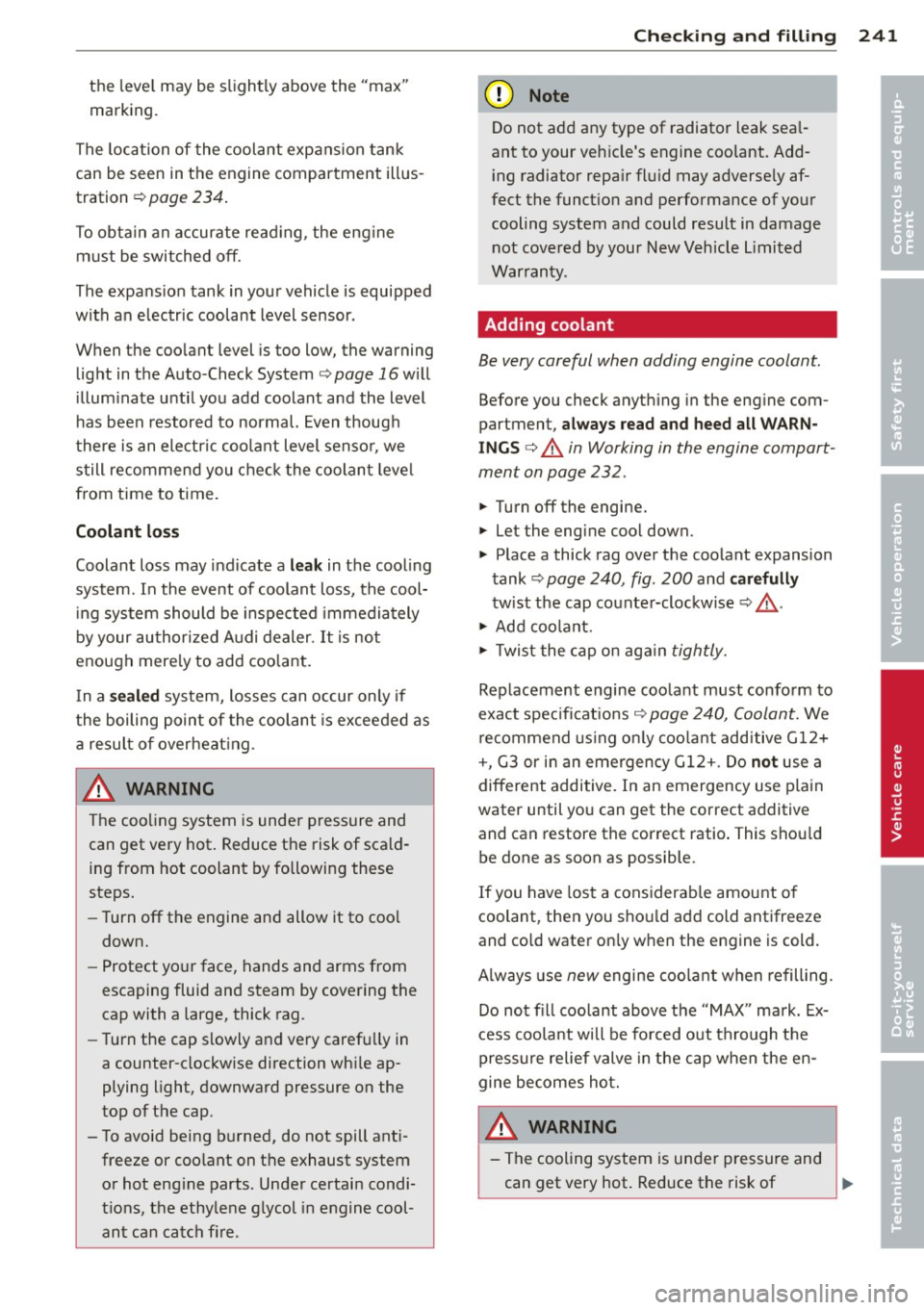
the level may be slightly above the "max"
marking .
The location of the coolant expansion tank
can be seen in the engine compartment illus
tration ¢
page 234.
To obtain an accurate reading, the engine
must be switched
off.
The expansion tank in your vehicle is equipped
with an electric coolant level sensor.
When the coolant level is too low, the warning
light in the Auto-Check System
¢page 16will
illuminate until you add coolant and the level
has been restored to normal. Even though
there is an electric coolant level sensor , we
still recommend you check the coolant level
from time to time.
Coolant loss
Coolant loss may indicate a leak in the cooling
system. In the event of coolant loss, the cool
ing system should be inspected immediately
by your authorized Audi dealer.
It is not
enough merely to add coolant.
In a
sealed system, losses can occur only if
the boiling point of the coolant is exceeded as
a result of overheating.
& WARNING
The cooling system is under pressure and
can get very hot. Reduce the risk of scald
ing from hot coolant by following these
steps.
- Turn
off the engine and allow it to cool
down.
- Protect your face, hands and arms from
escaping fluid and steam by covering the
cap with a large, thick rag.
- Turn the cap slowly and very carefully in
a counter-clockwise direction while ap
plying light, downward pressure on the
top of the cap.
- To avoid being burned, do not spill anti freeze or coolant on the exhaust system or hot engine parts . Under certain condi
tions, the ethylene glycol in engine cool
ant can catch fire .
Checking and filling 241
@ Note
Do not add any type of radiator leak seal
ant to your vehicle's engine coolant. Add
ing radiator repair fluid may adversely af
fect the function and performance of your
cooling system and could result in damage not covered by your New Vehicle limited
Warranty .
Adding coolant
Be very careful when adding engine coolant.
Before you check anything in the engine com
partment,
always read and heed all WARN
INGS ¢ & in Working in the engine compart
ment on page 232 .
.,. Turn off the engine .
.,. let the engine cool down.
.,. Place a thick rag over the coolant expansion
tank ¢
page 240, fig . 200 and carefully
twist the cap counter-clockwise ¢&_ .
.,. Add coolant.
.,. Twist the cap on again
tightly.
Replacement engine coolant must conform to
exact specifications ¢
page 240, Coolant. We
recommend using only coolant additive G12+
+, G3 or in an emergency G12+. Do
not use a
different additive. In an emergency use plain
water until you can get the correct additive
and can restore the correct ratio. This should
be done as soon as possible.
If you have lost a considerable amount of
coolant , then you should add cold antifreeze
and cold water only when the engine is cold.
Always use
new engine coolant when refilling.
Do not fill coolant above the "MAX" mark. Ex
cess coolant will be forced out through the pressure relief valve in the cap when the en
gine becomes hot.
A WARNING
- The cooling system is under pressure and
can get very hot. Reduce the risk of
II-
•
•
Page 252 of 318
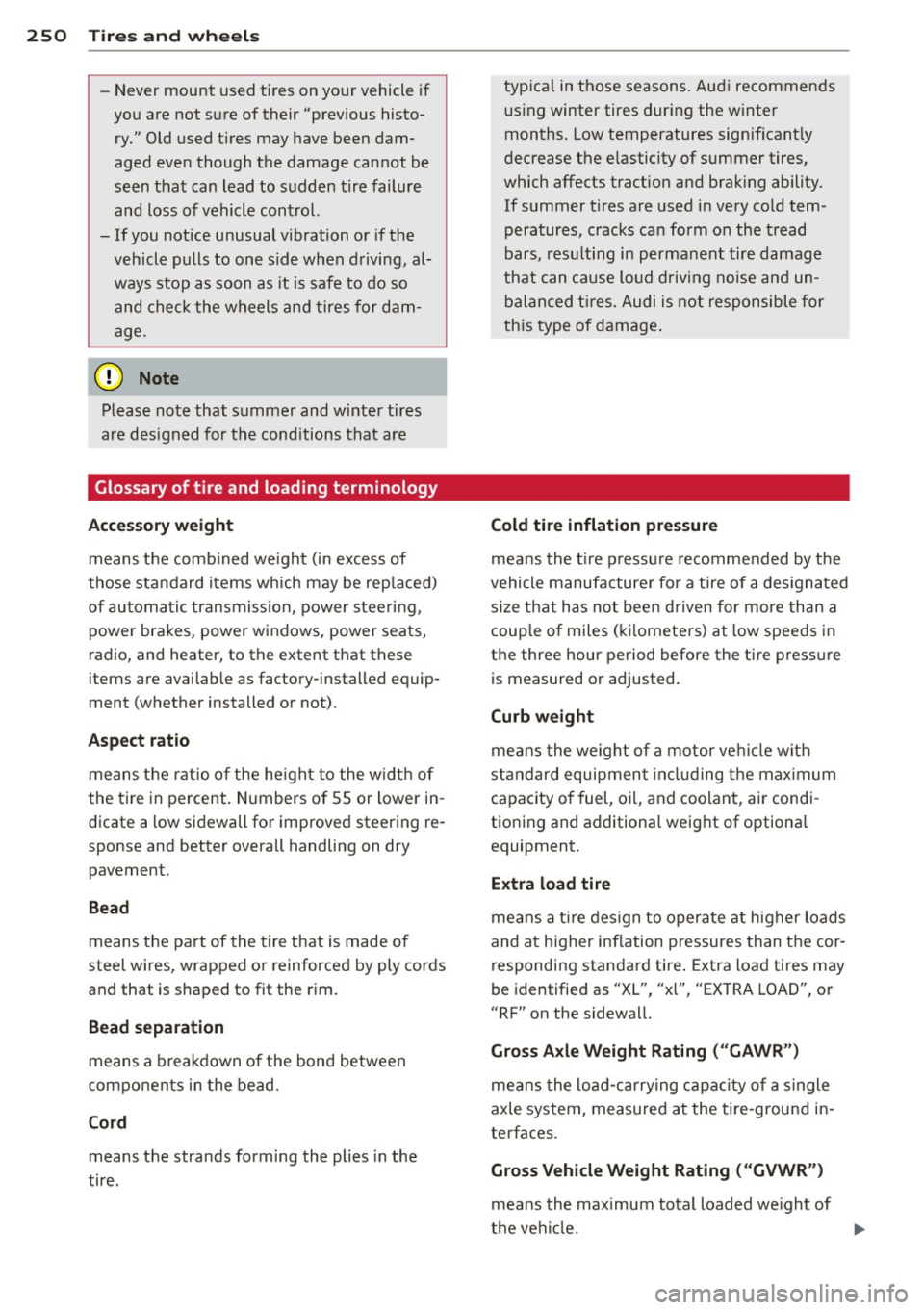
250 Tire s and wheel s
-Never mount used tires on yo ur vehicle if
you are not sure of their "previous histo
ry." Old used tires may have been dam
aged even though the damage cannot be
seen that can lead to sudden t ire failure
and loss of vehicle control.
- If you notice unusual vibration or if the
vehicle pulls to one side when driving, al
ways stop as soon as it is safe to do so
and check the wheels and tires for dam
age.
(D Note
Please note that summer and wi nte r tires
are designed for the cond itions that are
Glossary of tire and loading terminology
Accessory weight
means t he comb ined we ight (in excess of
those sta ndard items which may be rep laced)
of au toma tic tra nsmission, power steer ing,
power brakes, power windows, power seats,
radio, and heater, to the extent that th ese
items are availab le as factory -installed equip
ment (whether installed or not) .
Aspect ratio
means t he ratio of the he ight to the w idth of
the tire in percent . Numbers of 55 or lower in
dicate a low sidewall for improved steering re
sponse and better overall handling on dry pavement .
Bead
means the part of the ti re that is made of
steel wires, wrapped or reinforced by ply cords
and that is shaped to fit the rim.
Bead separation
means a b reakdown of the bond between
components in the bead.
Cord
means the strands forming the plies in the
tire . typ
ica l in those seasons . Aud i recommends
using winter tires during the winter
months . Low temperatures signif icant ly
decrease the e lasticity of summer tires,
which affects tract ion and brak ing ability.
If summer tires are used in very co ld tem
peratures, cracks ca n form on the tread
bars, res ulting in permanent tire damage
that can cause loud driving no ise and un
balan ced t ires. Audi is not responsible for
th is type of damage .
Cold tire inflation pressure
means the tire p ressu re recommended by t he
vehicle manufacturer fo r a tire of a des igna ted
s iz e that has not bee n driven for more than a
coup le of miles (k ilometers) at low speeds in
t h e three hour period before the tire pressure
is measured or adjusted.
Curb weight
mea ns the we ight of a motor ve hicle with
standard equipment in cl uding the max imum
capacity of fuel, oil, and coolant, air condi
tioning and additional weight of optiona l
equipment.
Extra load tire
me ans a t ire design to operate at higher loads
and at h igher inflation pressures than the cor
responding standard tire . Extra load tires may
be identified as "XL", "x l" , "EXTRA LOAD", or
"RF" on the sidewall.
Gross A xle Weight Rating ("GAWR ")
means the lo ad -c a rry ing c apac ity of a s ingle
axle system , measured a t the tire-ground in
terfaces.
Gross Vehicle Weight Rating ("GVWR ")
mea ns the maximum total loaded we ight of
t h e ve hicl e. .,.
Page 262 of 318

260 Tires and wheels
-Vehicles with front-wheel drive experience
more tread wear on the front wheels com
pared to all-wheel drive (quattro ®).
- Please rotate tires as shown
¢fig. 207.
- Extra care must be taken when rotating di-
rection-specific tires
¢ page 2 78.
Wheel balancing
The wheels on new vehicles are balanced .
H owever, various situations during everyday
driving can cause them to become unbal
anced , resu lting in vibrations you can usually
feel through the steering wheel.
Unba lanced wheels must be rebalanced to
avoid excessive wea r on steering , suspens ion
and tires . A wheel must also be rebalanced
when a new tire is installed.
Incorrect wheel alignment
Incorrect whee l alignment can cause exces
sive tire wear, impair ing the safety of the vehi
cle .
If tires show excess ive wear, have the
wheel alignment checked by an authorized
Audi dealer or qualified workshop.
All Wheel Drive
Vehicles with quattro® must always have ti res
of the same size, construction and tread type.
F or details see
¢page 203.
A WARNING
Sudden tire failure can lead to loss of con
trol, a crash and serious personal injury!
- Never drive a vehicle when the tread on
any tire is worn down to the wear indica
tors.
- Worn tires are a safety hazard, they do
not grip well on wet roads and increase
your risk of "hydrop laning" and loss of
control.
- Always keep chemicals that can cause
tire damage, such as grease, oil, gasoline
and brake fluid away from tires.
- Tires age even if they are not be ing used
and can fail suddenly, especially at high
speeds. Tires that are more than 6 years old can only be used in an emergency and then with specia
l care and at lower
speeds.
- Never mount used tires on your vehicle if
you are not sure of their "previous histo
ry." Old used tires may have been dam
aged even though the damage cannot be
seen that can lead to sudden tire failure
and loss of vehicle control.
New tires and replacing tires and wheels
New tires and wheels have to be broken in.
Fig. 208 Tir e spec ificatio n codes on the s idewall of a
tire
No.
©
®
®
0
®
®
@
Description
Passenger car tire (where applicable)
Nominal width of tire in mill imeters
Ratio of height to width (aspect ratio)
Rad ial
Rim diameter code
Load index and speed rating
U.S. DOT tire identification number
Aud i Original tire
Sever snow conditions
Tire ply composition and materials
used
Maximum load rating
Page 268 of 318

26 6 T ire s and whee ls
- Remove snow chains before driving on
roads not covered with snow to avoid
damaging t ires and wearing the snow
chains down unnecessarily.
- Snow chains, which come into d irect con
tact with the wheel rim, can scratch or
damage it. Therefore, make sure that the
snow chains are suitably covered . Check
the position of the snow chains after
driving a few yards and correct if neces
sary. Follow the instructions from the
snow chain manufacturer when doing so.
- If the Adaptive Air Suspension should
malfunction, do not mo unt or use snow
cha ins beca use the veh icle will be ex
tremely low. If you do drive with snow
chains on while the vehicle is at this lev
el, the snow chains might severely dam
age the wheelhouse and other parts of
the veh icle.
Where snow chains are mandatory oncer
tain roads, this normally also applies to
veh icles with All Wheel Drive.
Wheel bolts
Wheel bolts must always be tightened to the
correct torque.
The design of whee l bolts is matched to the
factory installed rims. If different rims are fit
ted, the correct wheel bolts with the r ight
length and correctly shaped bolt heads must
be used. This ensures that wheels are fitted
securely and that the brake system functions
cor rectly .
In certain circumstances, you may not use
wheel bolts from a different vehicle - even if it is the same model
~ page 298.
A WARNING
Imprope rly tightened o r maintained wheel
bolts can be come loose caus ing loss of control, a col
lision and serio us personal in
jury.
- Always keep the wheel bo lts and the
threads in the whee l hubs clean so the
wheel bo lts can turn easily and be prop
erly tightened.
- Never grease or oil the wheel bolts and
the threads in the wheel hubs. They can become loose while driv ing if greased or
oiled, even if t ightened to the specified
torque.
- Only use wheel bolts that belong to the rim being installed .
- Never use different wheels bolts on your
veh icle.
- Always ma intain the correct tightening
torque for the whee l bolts to reduce the
risk of a wheel loss. If the tightening tor
que of the wheel bolts is too low, they
can loosen and come out when the vehi
cle is mov ing. If the tig htening torq ue is
too high, the wheel bolts and threads
can be damaged and the whee l can be
come loose .
(D Note
The specified torque for the whee l bolts is
90
ft l b (120 Nm) with a tolerance of± 7,4
ft lb(± 10 Nm) . Torque whee l bolts diago
nally . After changing a whee l, the torque
must be checked as soon as possible with a
torque wrench -preferably by an author
i zed Audi dealer or qualif ied workshop.
Low aspect ratio tires
Your Audi is factory-equ ipped w ith low aspect
ratio tires . These tires have been thoroughly
tested and been se lected specifically fo r your
model for their superb perfo rman ce, road fee l
and hand ling under a variety o f driving condi
tions. Ask your authorized A udi dealer for
more details .
T he low aspect ratio of these tires is ind icated
by a numera l of
55 o r less in the tire's s ize
designation. The numeral rep resents the ratio
of the tire's sidewa ll height in relation to its
ll-
Page 291 of 318
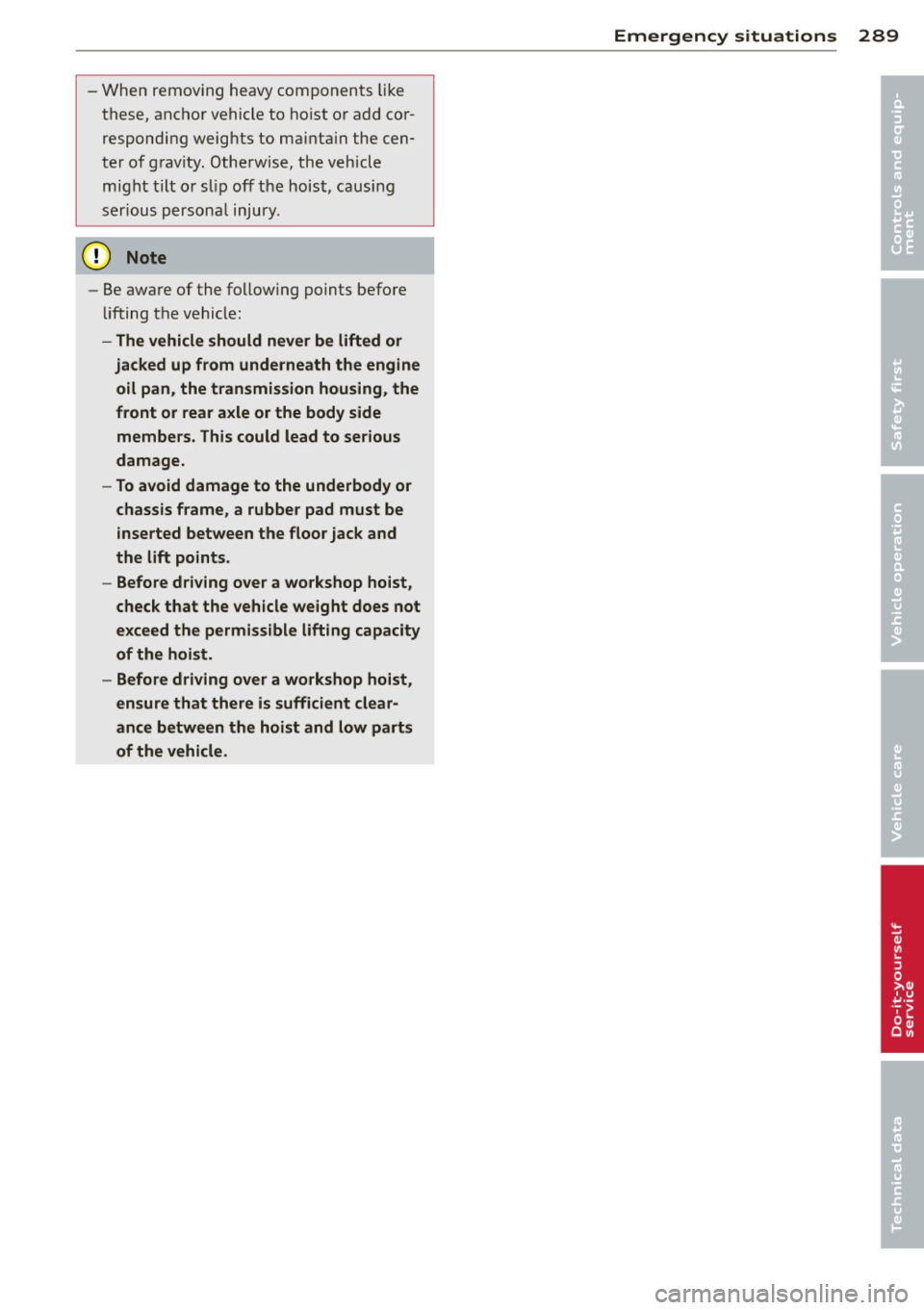
-When removing heavy components like
these, anchor vehicle to hoist o r add cor
respond ing weig hts to mai nta in the cen
ter of g ravity. Otherwise, the vehicle
m ight tilt o r slip off the hois t, causi ng
ser ious persona l injury .
Q) Note
-Be awa re of the fo llow ing points befo re
li fting t he vehicle:
- The vehicle should never be lifted or
jacked up from underneath the engine
oil pan, the transmission housing , the
front or rear axle or the body side members. This could lead to serious
damage.
- To avoid damage to the underbody or
chassis frame, a rubber pad must be
i nserted between the floor jack and
the lift points .
- Before driv ing over a workshop hoist,
check that the veh icle weight does not
exceed the permissibl e lifting capacity
of the hoist.
- Before driving over a workshop hoist,
ensure that there is sufficient clear ance between the hoist and low parts
of the vehicle.
Emergency situations 289
•
•